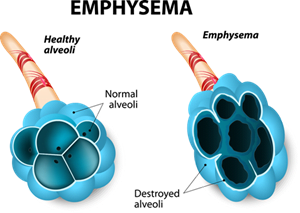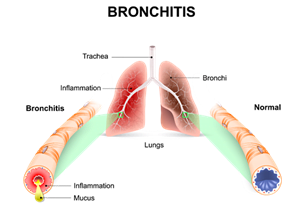COPD Overview
This information was reviewed and approved by Russell P. Bowler, MD, PhD, Irina Petrache, MD (3/1/2021).
Chronic obstructive pulmonary disease (COPD) affects more than 24 million people in the United States. “Chronic" means long term, "obstructive" means it is hard to get air out of the lungs. The most familiar diseases in this group are emphysema and chronic bronchitis. A person with COPD may have emphysema, chronic bronchitis, or both. COPD shares characteristics of asthma.
COPD is chronic obstructive pulmonary disease. Chronic means the condition is going to be there, it's been there for a long time, it's going to be there for a long time, but the good news is that COPD is treatable in addition to being long standing. Obstructive refers to the fact that the breathing test has a certain kind of abnormality with air flow limitation. Pulmonary disease, it's a problem of the lungs inside the chest.
Shortness of breath, cough and phlegm are the major symptoms of COPD that drives patients to come see their physician. Shortness of breath is sometimes first recognized as inability to do what you normally can do. In addition, many patients have what's called exacerbations. That means some acute respiratory event which is associated with more shortness of breath, more cough, more phlegm, those exacerbations are very important and need to be treated appropriately and rapidly.
The most important and common diagnostic test for COPD is a breathing test. The name of that breathing test is spirometry, but it's pretty simple. It requires you to take a deep breath in and blow it out as hard and fast as you can. With that test, we find out that the air passages are narrow and that's sort of the classic definition of COPD along with symptoms. In addition, there's some other tests that people sometimes have. They may go in and have a CAT scan of their chest because they have some other respiratory complaint and one finds emphysema on their chest x-ray. Breathing tests and x-rays are the most common ways we diagnose COPD.
The important thing that people should know about COPD is it's treatable. Think about what symptoms you have as an individual. If you have shortness of breath, we have lots of treatments for that. One of the important treatments is actually a non-medical treatment, at least a non-medication treatment and that's exercise. If you exercise regularly, you'll be able to do more before you get out of breath. A regular exercise program is sometimes started as what's called pulmonary rehabilitation, a program of exercise and education that allows people to do more, be more active through a regular exercise program that's targeted for them. In addition, we also have treatments related to medications that one needs to breathe in. There are a lot of different kinds and classes of medications that help people be less short of breath when they have COPD by using these medications on a regular basis.
 Let’s take a look inside the lungs to see what is happening. The air sacs, also called alveoli, and the airways have been damaged in COPD, most often by cigarette smoking or poor air quality. In the healthy lung, the air sacs or alveoli look like a bunch of grapes. Look at the alveoli of emphysema. In emphysema, the walls of the alveoli are partially destroyed. This results in a smaller total number of alveoli in the lungs. Fewer air sacs mean that the lungs are not able to absorb oxygen into the bloodstream as well expel carbon dioxide. Also the airways may collapse a little.
Let’s take a look inside the lungs to see what is happening. The air sacs, also called alveoli, and the airways have been damaged in COPD, most often by cigarette smoking or poor air quality. In the healthy lung, the air sacs or alveoli look like a bunch of grapes. Look at the alveoli of emphysema. In emphysema, the walls of the alveoli are partially destroyed. This results in a smaller total number of alveoli in the lungs. Fewer air sacs mean that the lungs are not able to absorb oxygen into the bloodstream as well expel carbon dioxide. Also the airways may collapse a little.
 Now look at the healthy airway. Air moves in and out of the middle of the airway. Now look at the airway of chronic bronchitis. In chronic bronchitis, the airway walls are swollen and produce more mucus. In chronic bronchitis a person has a chronic productive cough. This is often due to cigarette smoking.
Now look at the healthy airway. Air moves in and out of the middle of the airway. Now look at the airway of chronic bronchitis. In chronic bronchitis, the airway walls are swollen and produce more mucus. In chronic bronchitis a person has a chronic productive cough. This is often due to cigarette smoking.
The earliest symptom of COPD is more shortness of breath with strenuous activity than what would normality be reported from someone of a similar age. Many people do not realize this and may simply reduce the amount of activity they do. An example includes running for the bus. Later symptoms with COPD include shortness of breath with lesser activity. An example includes walking across the street.
COPD was once deemed to be a disease with a hopeless prognosis, but is now known to be very treatable. Early diagnosis and treatment can enable people with COPD to take charge of their breathing and regain control of their lives. Common treatment goals include becoming more active, decreasing shortness of breath, a lowering of anxiety and depression and an improved quality of life.
Quit Smoking
Even if you have COPD, symptoms are milder and chances of living longer are improved if you quit smoking. It is never too late to quit smoking if you have COPD or are at risk for developing COPD because of a smoking habit. When you quit smoking you will:
- Live longer
- Have decreased cough and phlegm (mucus)
- Slow loss of lung function and symptom progression.
As more people quit smoking, fewer will develop COPD, and its prevalence should continue to decline.
Alpha-1 Antitrypsin
A person who doesn't have enough alpha-1 antitrypsin, a major protein in the blood, might have Alpha-1 Antitrypsin Deficiency, sometimes called Alpha-1. When Alpha-1 affects the lungs, it can cause COPD and is called inherited emphysema. And when it affects the liver, it is called inherited liver disease. Learn more about alpha-1 antitrypsin.
National Jewish Health experts provided information on this topic for use on the U.S. News & World Report website.
 Clinical Trials
Clinical Trials
For more than 100 years, National Jewish Health has been committed to finding new treatments and cures for diseases. Search our clinical trials.
